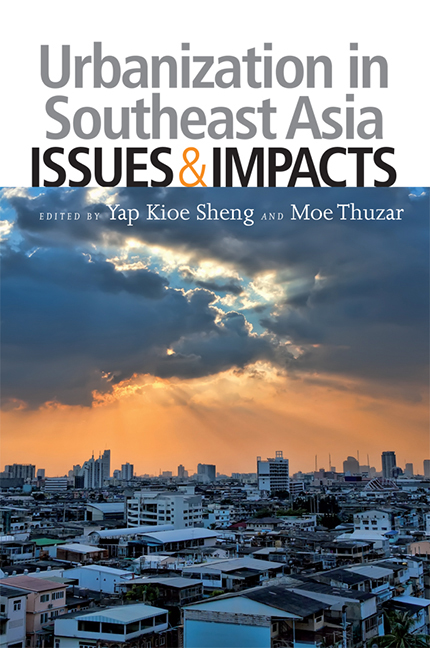Book contents
- Frontmatter
- Contents
- Message from Head, ASEAN Studies Centre
- Message from Director, Centre for Liveable Cities
- About the Contributors
- Introduction
- Urbanization in Southeast Asian Countries: Recommendations
- 1 The Challenges of Promoting Productive, Inclusive and Sustainable Urbanization
- Cities as Engines of Development
- Inclusive Cities
- Cities and the Environment
- 9 Climate Change and Southeast Asian Urbanization: Mitigation and Adaptation Considerations
- 10 Urban Green Spaces and Liveability in Southeast Asia
- 11 Decentralized Waste Water Management for the Waste Water Revolution in Urban Areas to Support the Engines of Development in Southeast Asia
- Governance, Decentralization, and Urbanization
- Urbanization from an ASEAN Perspective
- Index
10 - Urban Green Spaces and Liveability in Southeast Asia
from Cities and the Environment
Published online by Cambridge University Press: 21 October 2015
- Frontmatter
- Contents
- Message from Head, ASEAN Studies Centre
- Message from Director, Centre for Liveable Cities
- About the Contributors
- Introduction
- Urbanization in Southeast Asian Countries: Recommendations
- 1 The Challenges of Promoting Productive, Inclusive and Sustainable Urbanization
- Cities as Engines of Development
- Inclusive Cities
- Cities and the Environment
- 9 Climate Change and Southeast Asian Urbanization: Mitigation and Adaptation Considerations
- 10 Urban Green Spaces and Liveability in Southeast Asia
- 11 Decentralized Waste Water Management for the Waste Water Revolution in Urban Areas to Support the Engines of Development in Southeast Asia
- Governance, Decentralization, and Urbanization
- Urbanization from an ASEAN Perspective
- Index
Summary
While there are diverse definitions of liveability, few would disagree that green spaces are an important contributor to liveability in urban places. In a paper published in 1987, two officers from the Department of Environmental Management of the United Nations Environment Programme (UNEP) agreed that “there is consensus in the view that the quality of urban life depends largely on the amount and quality of green space within it or close to it” (Olembo and Rham 1987). The former mayor of Bogota, Colombia, Enrique Penalosa, went as far as to expound that “parks and other pedestrian places are essential to a city's happiness” (PPS 2003).
Indeed, many studies have shown the multiple benefits of urban green spaces for the social, environmental, and economic well-being of urban communities. The well-being of these three spheres is essential for building a liveable city. In addition, good governance and integrated planning are necessary as they facilitate programmes and policies that ensure the health and well-being of the three spheres.
Liveability is defined as the suitability to live in a place and is often associated with the city's environmental quality, health, and quality of life (Mamas and Komalasari 2008). Beyond basic needs such as sanitation and water, there are social, economic, and environmental health needs. The provision of urban green spaces is a prime example of how policy programmes can effectively augment the social, environmental, and economic liveability of a city. This chapter will explore how urban green spaces are increasingly being recognized as an important source of fulfilment of social, environmental, and economic needs in Southeast Asian cities.
ROLE OF URBAN GREENERY
The terms “urban greenery” or “urban green spaces” include everything in cities that has vegetation, also collectively known as “green infrastructure” (Gairola and Noresah 2010). It includes horticultural parks, streetscapes, green areas, and open spaces, as well as forests and other natural habitats of urban biodiversity such as riverine and coastal parks. Such a broad definition is necessary as a city's geography and history shape its urban greenscape differently. Some recent developments in horticultural parks have further blurred the divide by attempting to “recreate naturalistic landscapes … characterized by informal design, favourable maintenance to wildlife and a preference for native vegetation” (Tzoulas and James 2004). A common denominator in all is the role of these green spaces and parks as a type of urban open space.
- Type
- Chapter
- Information
- Urbanization in Southeast AsiaIssues and Impacts, pp. 262 - 276Publisher: ISEAS–Yusof Ishak InstitutePrint publication year: 2012



